Q&A – Ask Neil: November 3, 2022
(Please read these instructions carefully.)
Before you post your question, please look at recent issues to see if someone else has already asked it. You might find your answer there.
How to submit your question…
• Click here to post your question.
• After you submit your question, a new window will pop up giving you the address to which you can e-mail a photo to accompany your question. Clear, medium-resolution photos. (Try to avoid low-res thumbnail photos, please, in case I have to zoom in to see things.)
• Please only post your question one time.
• One question per reader, please.
• Please use this only for posting questions – not for standard emails.
• Watch for your answer in the following week’s e-gardens.
• I choose those of greatest general interest. For example, plant IDs seldom make the cut.
• I must have your first name or initials.
• I must have your city or county. (Texas is a very large state.)
QUESTION 1
WHAT CAN WE PLANT TO CONCEAL POOL EQUIPMENT AND AC UNIT ON HOT SIDE OF HOUSE?
Question: Our pool equipment and air conditioning unit are on the southwest side of our house facing a public road. We need to plant something that could be kept at 5 to 6 ft. tall and wide to conceal them. Intense heat killed the Burford hollies, and disease got the photinias before them. Help! Dennis A., Travis Co.
Answer: I have used dwarf Burford holly in many, many similar settings over the past 45 years, almost all of them in full sun. That includes at our house and in the hottest of locations (full sun and against a concrete sidewalk) at our son’s house. That plant can absolutely handle the heat. What they cannot handle is drought – getting too dry for even one day. I saw literally thousands of hollies that were allowed to dry up this summer, some of them quite old and well established. (You’ll see examples in a later question this section.) People just didn’t realize that the plants were passing the point of no return as they were getting too dry since hollies don’t wilt. You probably saw the story I wrote here on the entire commercial landscape at a large convenience store in Frisco with several tens of thousands of dollars’ worth of landscaping that was allowed to die from drought. Just $100 worth of well-timed irrigation could have saved all of it. Hollies would absolutely be my first choice in your setting, either dwarf Burford or if you need something taller, Willowleaf or even Nellie R. Stevens. Forced to give you a second choice I’d go with Sea Green junipers.
QUESTION 2
WHY THE GREAT CONCERN ABOUT GRUBWORMS?
Question: Why the great concern about grubs? We’re not overrun with grubs, but we do have persistent moles. I’d much prefer to let the moles eat the grubs and not the earthworms. Do you disagree? David W., Mount Pleasant.
Answer: Yes, in fact, I do disagree. I don’t want either moles or grubworms. They both can do serious damage to my lawn. I have seen white grubworms take out entire city blocks of turfgrass when they were present in epidemic numbers. But I always tell people that they need to check to be sure that there are enough grubs (5 per square foot) to justify treating for them. If I had that many or more, I would not want to be counting on moles to be my first line of defense against them.
QUESTION 3
WHY DO LEAVES ON NELLIE R. STEVENS HOLLIES ROLL?
Question: What causes the leaves of this Nellie R. Stevens holly to roll? Denise S., Jacksonville.


Answer: The rolling doesn’t look very severe, and it appears to have happened sometime in the past. My guess, therefore, is going to be that the leaves were hit by a glancing drift of a broadleafed weedkiller (containing 2,4-D) when weeds were being sprayed somewhere nearby. It could also have been from residue left behind in a spray tank that wasn’t completely washed out. The plant should be fine by next spring.
QUESTION 4
WHY ARE JAPANESE BOXWOODS DYING?
Question: We are losing Japanese boxwoods that we planted last October. This is the fourth one to die out of 11. I feel like we’re watering them adequately. I don’t want to replace them with more if you think they’re a bad choice. I would rather replace all if you have a better suggestion. Angie S., Brenham.
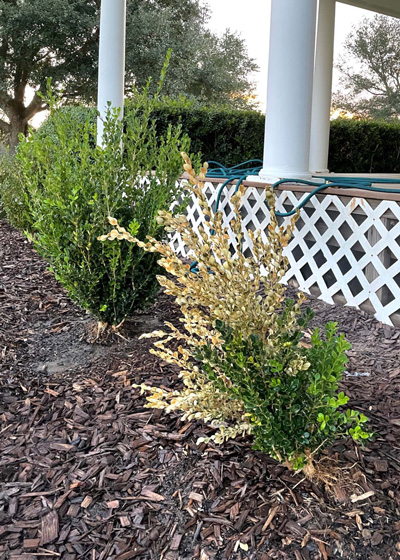
Answer: I believe your choice is fine. I’ve looked at your photo (and the others you sent) closely and I don’t see any evidence of insect or disease damage. It looks like the plants could have been allowed to get too dry during the drought. All it takes is one time. I also see way too many roots exposed on the one plant. Why is that plant so far out of the ground? That could account for a big part of the problem.
QUESTION 5
CAN THIS NELLIE R. STEVENS HOLLY BE SAVED?
Question: Can this Nellie R. Stevens holly be saved? It was planted at the same time as the other two. It received the same water as well. Julienne V., Austin.
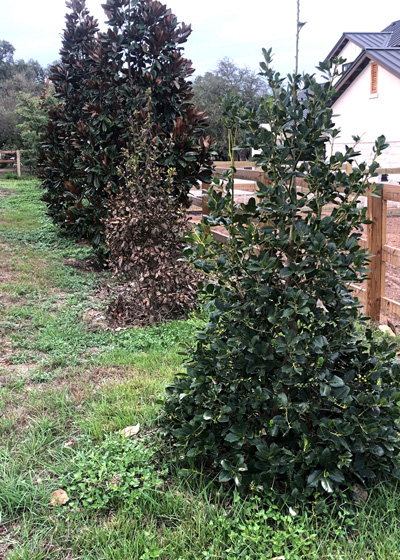
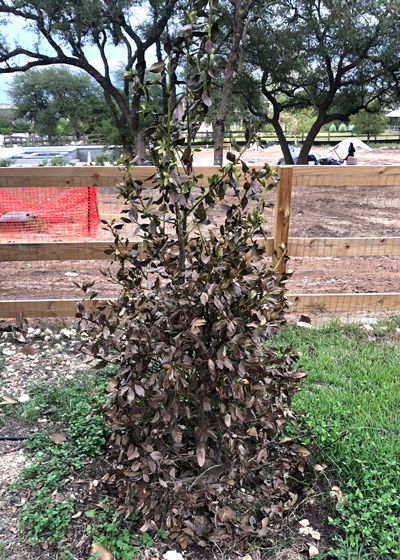
Answer: Absolutely the only thing that could have caused this to happen is that it got too dry one or more times during the hot summer weather. Plants don’t all dry out at exactly the same rate. As I mentioned in an earlier answer, I’ve seen thousands of hollies that died this summer due to the drought – even mature ones. Classic example in my own hometown: northbound access road of US75 between US380 and Wilmeth Road, probably 15 Nellie R. Stevens hollies that had grown to be 12 to 15 magnificent feet tall and 10 feet wide are dead now. Just $5 worth of water per tree applied one time in mid-summer would have saved them. There isn’t enough of your tree left behind for it to come back. It’s time to accept the learning losses and move on. (Sorry for the bad news.)
QUESTION 6
HOW CAN I CONTROL THIS WEED GRASS?
Question: I have a grassy weed/flower in my yard that first appeared three years ago. I had been pulling it out, but my neighbor has let it get out of control and it is spreading to my yard. How can I control it? Mark R., Tyler.
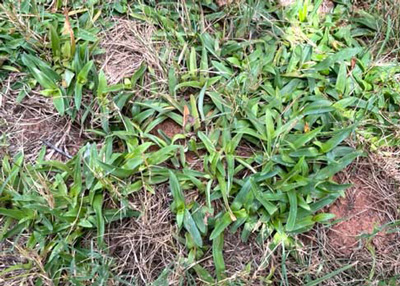
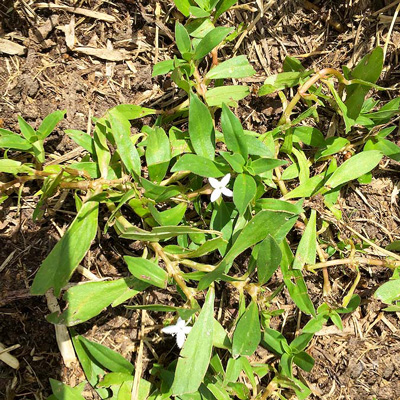
Answer: This is not a grassy weed, but a broadleafed weed called Virginia buttonweed. It has become much more common in recent years. Unfortunately, it is also difficult to control. This bulletin from Clemson University has good information as to how to deal with it. I’ve also attached a photo for your comparison. You must be persistent, and your neighbor needs to get with this same program immediately.
QUESTION 7
DO YOU HAVE A FAVORITE OF THE TALLEST CRAPE MYRTLES?
Question: I know you do a lot of work with crape myrtles. Do you have a favorite of the tallest types? (Those that grow to 25 ft. and taller.) Susan S., Irving.
Answer: You didn’t mention a color, so I’m going to take editorial license and admit that purple is my favorite of the crape myrtle colors. That’s because it combines best with other crape myrtle colors, also because it looks good with all building material colors. Catawba is my all-time favorite crape myrtle, but it may not get quite as tall as 25 feet. Twilight is a dark purple that is of that height. Red Rocket and Arapaho are two outstanding tall reds. Sarah’s Favorite White and Glendora White are my choices for whites. Here is a list from our Crape Myrtle Trails of McKinney. We polled experts as to their recommendations of the best types from each size range. Take a look.
One thing to remember: Many of the best-selling tall varieties have been selected by growers primarily because they grow quickly to a large size. But several of those also lack winter hardiness in North Texas (where you are). As a result, we of the Crape Myrtle Trails of McKinney no longer recommend Natchez, Tuscarora, Sioux, Muskogee or Country Red. They have frozen to the ground and had to be retrained time and again.
QUESTION 8
WHY ARE CLEYERA LEAVES YELLOWING?
Question: Why are my cleyeras’ leaves yellowing? I planted them last December and I’ve hand-watered them a couple of times a week since then. They get dappled shade in the morning and full shade in the afternoon. Camellias planted nearby have been fine for years but is this a lack of acidity? Lisa B., Mansfield.
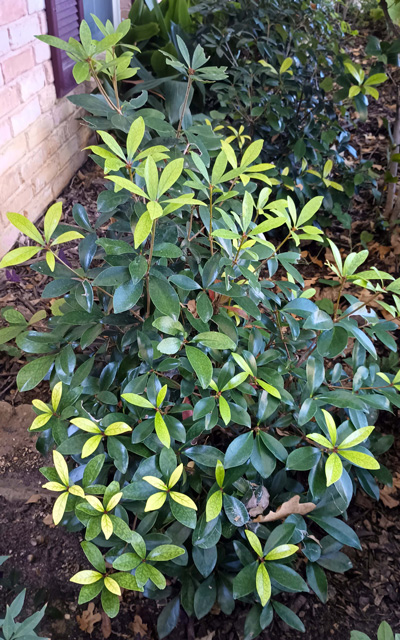
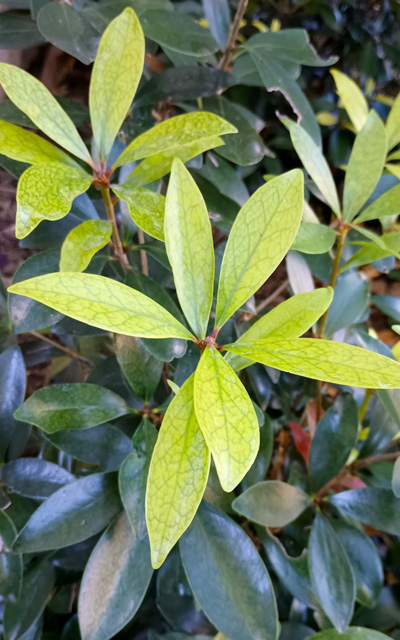
Answer: You have identified the problem correctly. This plant in your photo is running short of iron. Iron becomes insoluble in alkaline soils and in the presence of alkaline irrigation water. Next year, during the growing season, supply an iron additive plus a soil acidifier on a monthly basis. Keep iron products off bricks and mortar that could be stained. Be sure the drainage is perfect. Cleyeras are intolerant of waterlogged soils. At the same time, keep it moist at all times.
On a personal note, Lisa, I appreciated the photos and your kind comments about my old cowboy boot book I signed to your grandmother. It all really made my day. Thanks!
QUESTION 9
WHAT IS DATE OF PRODUCTION FOR NEWLY ACQUIRED THERMOMETER?
Question: Could you give me a date of production for my newly acquired thermometer? It is a treasure indeed. Gary S., Denison.
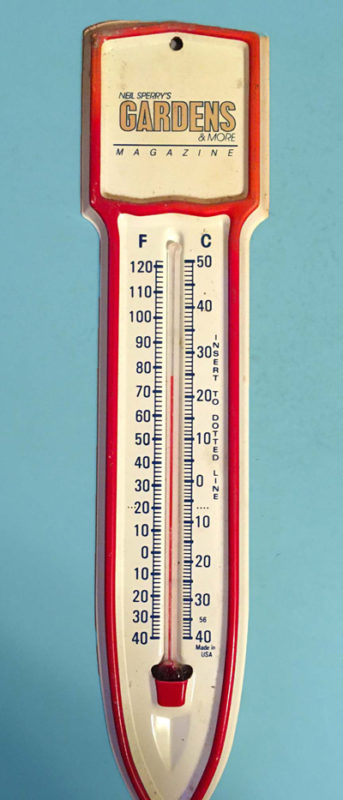
Answer: Gary, it’s always great to hear from you.
I’ve been in this business a long time! Production date? Sometime after Texas became a state. Fact is, I started the magazine in 1987, so it had to be after that date. I’m narrowing it down. Somewhere around the early 1990s. I’m going to guess 1992. What do I win?
QUESTION 10
WHAT IS THIS SMALL PLANT AND HOW CAN I GET IT OUT OF MY LAWN?
Question: I have this small flower/plant in my St. Augustine grass. It is in sun and shade and grows throughout the summer. What is it? More importantly, how can I get rid of it? Randa, Austin.
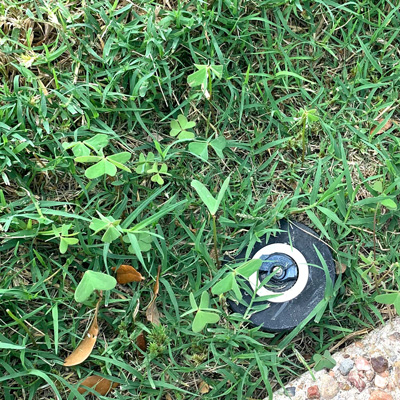
Answer: I don’t know as to its name. These don’t look like plants that been out there growing for very long. They look more like seedlings – the cotyledons, or “seed leaves.” I would guess it’s from the family Convolvulaceae, the morning glory family. My suggestion is that you wait for the first freeze. If that kills them, we’re good to go for a few months. When time comes to spray them, you can use a broadleafed weedkiiler spray containing 2,4-D. Read and follow label directions for best results.
QUESTION 11
WHAT GRASS WILL TAKE PLACE OF BERMUDA IN SHADE?
Question: After a year in my new home the bermudagrass areas on the sides of my house are apparently not getting enough sunlight as judged by growth and fullness. I am looking for an alternative besides St. Augustine, since the city frowns on such grass. Steve S., New Braunfels.
Answer: Good luck to the city. Bermuda needs full sunlight – or at least 8 hours daily to grow and thrive. St. Augustine needs 5 or 6, and that difference is critical when trees and structures become involved. This is the question I am asked most often, and the only other way out is to use some type of ground-covering material that won’t require much sunlight. It could be monkeygrass, English ivy or other groundcover, or it could decorative mulch or stone. But just legislating that people can’t grow St. Augustine because of water consumption doesn’t solve the problem. Even zoysias need more sun than St. Augustine. Someone needs to do serious studies on how much (actually, how little) water it takes to keep St. Augustine going. I have a good bit of it that has escaped onto a ½-acre hillside and it is never irrigated. This past summer was the first time that I have ever lost any of it, and then I only lost one small part of it. This is in Collin County, northeast of Dallas.
QUESTION 12
WHAT EATS AND KILLS THE BRANCHES OF MIMOSA BOREALIS?
Question: What could be eating the branches of my Mimosa borealis? It has killed six branches so far. Lora O., Williamson Co.
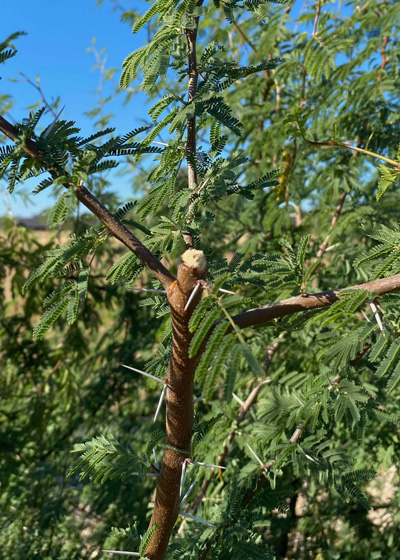
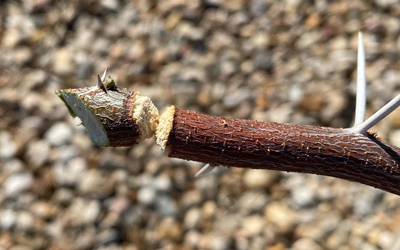
Answer: Twig girdlers. They’re beetles that score the twig with very sharp mouthparts after depositing eggs in the far ends of the branches. As the twigs die, they become brittle and fall to the ground. The larvae develop within the dead wood, emerging the following spring as adult girdlers to start the cycle over again. I feel your pain because I lost an expensive Harry Lauder’s walking stick (contorted filbert) to these innovative pests once, too. Unfortunately, there is no spray to control the adult girdler since she is there such a short time and since she does not actually feed on the twig. The larvae are protected by the wood of the twigs. All we can do is gather the fallen twigs and send them out with the trash.
QUESTION 13
CAN I KILL THIS MUSTANG GRAPE WITHOUT HARMING THE TREE?
Question: A mustang grape vine has taken root in this old wound in the oak tree. Is there any way to kill the vine without harming the tree? Mark M., Bexar Co.
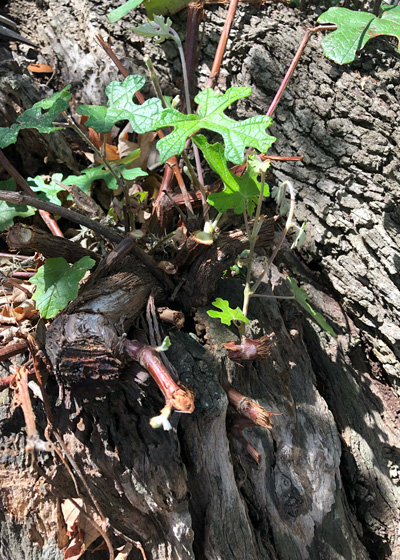
Answer: That’s very unusual. You’ll need to trim off as much as you can, then drill into the grape stem carefully in a way that you can inject a broadleafed weedkiller (containing 2,4-D) with an eyedropper into the “reservoirs” you’ve made in the grape vine. I couldn’t see it well enough to get any idea of where and how to do the drilling, but you’ll get an idea as you start. Just be sure you don’t drill into the tree trunk. One concern: the tree is severely weakened already. To have an area that would allow a grape to take root means there is a lot of decay already present. I would be concerned about the strength of the trunk in wind and ice storms.
